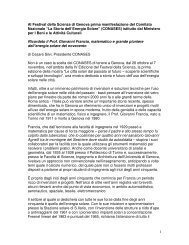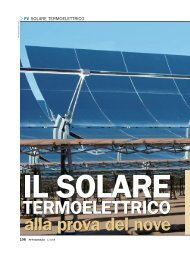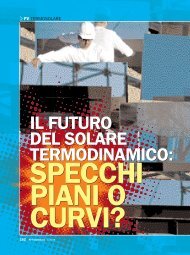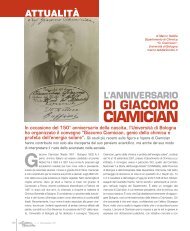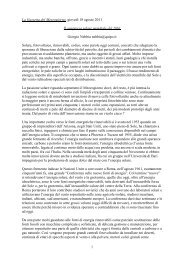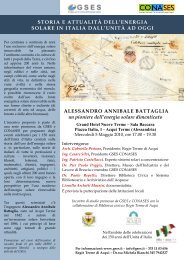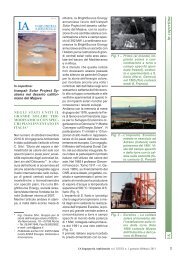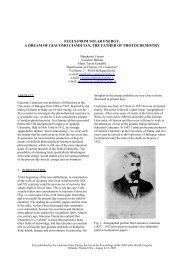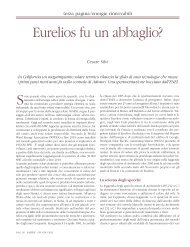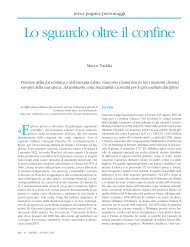The Pioneering Work On Linear Fresnel Reflector ... - GSES
The Pioneering Work On Linear Fresnel Reflector ... - GSES
The Pioneering Work On Linear Fresnel Reflector ... - GSES
Create successful ePaper yourself
Turn your PDF publications into a flip-book with our unique Google optimized e-Paper software.
Fig. 2. Left, Cross section of the collecting reflector area and the longitudinal grounded boiler, one<br />
meter in height, installed inside a brick oven, insulating and protecting the boiler and with an opened<br />
window facing the reflector area. Right, Plan of the collecting reflector area and of the longitudinal or<br />
linear boiler, roughly ten meters in length.<br />
<strong>The</strong> Multiple Solar Collector was Battaglia’s answer to the challenges of building large collectors, on which<br />
many scholars and scientists speculated during the 16 th and the 17 th centuries as illustrated in figure 3.<br />
Fig. 3. From a Golden Thread by Butti and Perlin: a large burning mirror of the late 1700’s built in<br />
sections [1].<br />
Battaglia’s approach, which won him special recognition from the Istituto di Incoraggiamento di Napoli,<br />
overcame, in theory, some of the limitations in the Mouchot-Pifre designs, though there still remained<br />
obstacles, that had already been encountered in the past, as shown in the image in figure 3. Judging from the<br />
drawings in Battaglia’s patent, the grounded boiler would require the mirrors to face downward and therefore<br />
are limited in the amount of sunrays they can capture and reflect toward the receiver.<br />
In any event, Battaglia introduced new concepts, such as a longitudinal or linear receiver and a multiple<br />
reflector area made of many small and flat reflectors, each one tracking the sun independently. Both the<br />
reflector area and the boiler could therefore grow in size to collect large quantities of solar energy in order to<br />
meet modern industrial demands.<br />
Historical research on Battaglia’s theories, as well as other work based on his patent registered in 1886,<br />
continue today. For example, research is being carried out to determine if Battaglia ever succeeded in<br />
building and testing a demonstration plant, as he was recommended to do by the Istituto di Incoraggiamento<br />
di Napoli during his presentation in 1884.<br />
2.2 Other little known Italian attempts in the 19 th century to produce solar steam<br />
Prior to Battaglia’s work, other Italians had considered the possibility of building large solar concentrators to<br />
produce solar steam during the 19 th century. Among them it is worth recalling Pasquale Gabelli (1801 –1882)<br />
and Bartolomeo Foratti. Gabelli, a professor of mathematics and natural science, born near Pordenone in<br />
northern Italy, presented a handwritten document “Sopra un nuovo meccanismo per dirigere i raggi solari<br />
condensati ad usi speciali” (<strong>On</strong> a new mechanism to direct condensed solar rays for special purposes) at the




